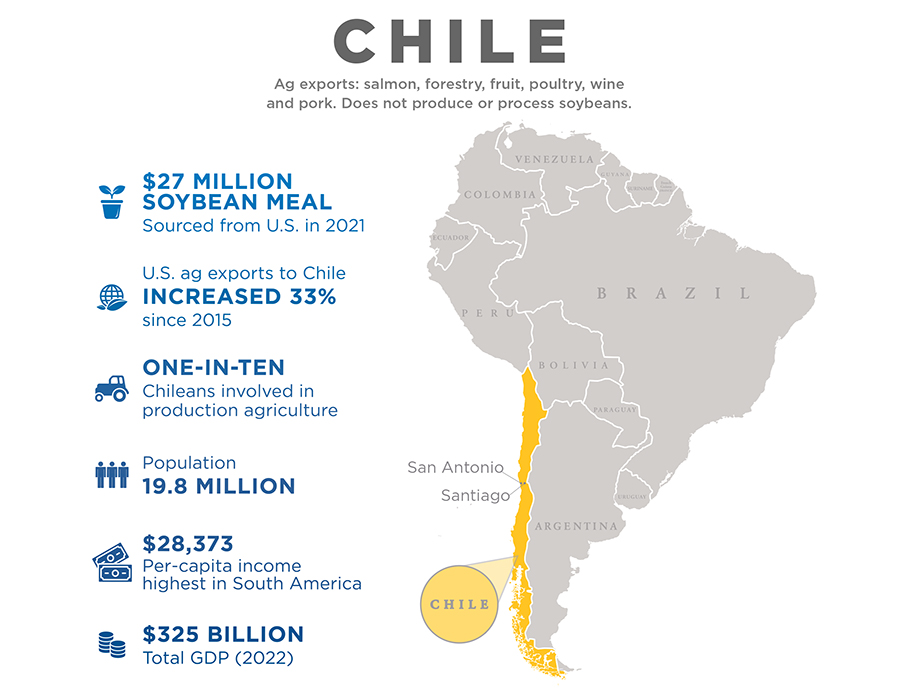Price sells soybeans during trade mission to Chile
September 1, 2023 | Aaron Putze, APR
If you want the attention of a Chilean involved in meat and poultry production, tell them the U.S. will soon have larger quantities of soybean meal competitively priced and ready for export.
It was a message repeated often by Midwest soybean farmers. And the pitch was well-received by pork, chicken and poultry producers committed to feeding Chile’s 20 million people.
“More soybean crush for oil to make biofuels here in the U.S. means more soybean meal available for export,” says Suzanne Shirbroun. “And that supply will be priced to move.”
The northeast Iowa farmer and president-elect of the Iowa Soybean Association shared the bottom-line message during a weeklong trade mission in early June.
Representatives of Chile Carne, a federation representing the country’s poultry and pork producers, processors and exporters, were especially receptive to the pitch during a free-flowing conversation held at its offices in downtown Santiago, the country’s capital.

Anxious
In addition to keeping African Swine Fever at bay and increasing public support for construction of new farms, meat and poultry producers in Chile are continually anxious about accessing quality and affordable ingredients for livestock and poultry feed.
Known globally for its copper, wine, forestry and salmon production, Chile doesn’t grow one bushel of soybeans.
“We’re a small country with no soy and just a little corn” says Juan Carlos Dominguez, Chile Carne’s executive president. “Imports of feedstock is critical.”
An engaging personality with a passion for Chilean agriculture, Dominguez didn’t hold back on the industry’s needs, starting with access to quality and affordable feedstuffs.
“It’s a huge challenge to produce poultry and pork without it, but thanks to U.S. farmers, we’re able to import the raw material and then export our meat to Canada and Asia,” he says.
Chile is a free trade country, shipping and receiving products from more than 60 countries, including the U.S. Combined, these economies comprise nearly 90% of global GDP and are home to 5.1 billion people.
“We buy raw material from abroad, transform it into protein, and then send it back into the market,” Dominguez says. “We’re always in motion depending on what works best for our country and customers.”
For example, Chile exports a massive amount of chicken wings to the U.S., especially in advance of the NFL’s big game held in February.
Last year, 70% of Chile’s pork production was shipped to major export hubs including China, Korea, Japan, Columbia and Mexico. It also imported product from Brazil, U.S., Spain, and Germany.
While Chile’s livestock and poultry producers welcome increased competition and lower prices for soybean meal, they are tense about the industry’s prospects for expansion.

Operation scuttled
Most of the industry’s red meat and poultry production is highly integrated. Chilean companies like AgroSuper and Ariztia are respected for their production success. But the construction of new farms and processing facilities are often the target of organized opposition.
A $500 million dollar facility proposed in a sparsely populated area in northern Chile was recently scuttled after opponents voiced concerns about increased traffic, dust, noise and odor.
“Even with all the investment made by the industry in the last 10 years, we have only been able to build one new production area within 300 kilometers of Santiago,” Dominguez concedes, adding that Chilean agriculture receives no government subsidies.
Gaining the necessary permits to expand existing facilities is even more onerous.
“Our past condemns us, but we are working, always trying to do better,” Dominguez adds.
Producers are equipping facilities with state-of-the-art manure and odor management technology, reducing water usage, and becoming more engaged in the communities they and their employees call home.
Pork and poultry account for nearly 90% of Chile’s meat exports valued at more than $1.5 billion. Almost 70% of Chilean’s poultry and 60% of its turkey production hits the Atlantic Ocean for voyages to the U.S., Mexico, and China.
Chile ranks 6th in global pork exports and 13th in poultry. Its primary soybean meal suppliers are Bolivia, Argentina and Paraguay. U.S. and Midwest soybean farmers intend to change that.
Quality matters
Chile’s economy is the most vibrant in South America. This affluence combined with its ability to be a nimble and efficient trader make Chile an intriguing market opportunity for soybean farmers like Shirbroun.
“They’re not going to be a China or Mexico, but they are savvy buyers and ready traders,” she says. “And they see U.S. products and brands as high-quality.”
Chilean meat and poultry producers and the organizations that represent them are also key on improving their environmental and sustainability standings.
The U.S. Soy Sustainability Assurance Protocol was launched in 2013. It provides customers of U.S. soy verification of the sustainability methods practiced by U.S. soybean farmers nationwide.
“They took note of our commitment to sustainability,” Shirbroun added. “That, combined with a more competitive price, bodes well for making more sales to Chile and other countries wanting a high-quality and reliable feedstock.”
Back